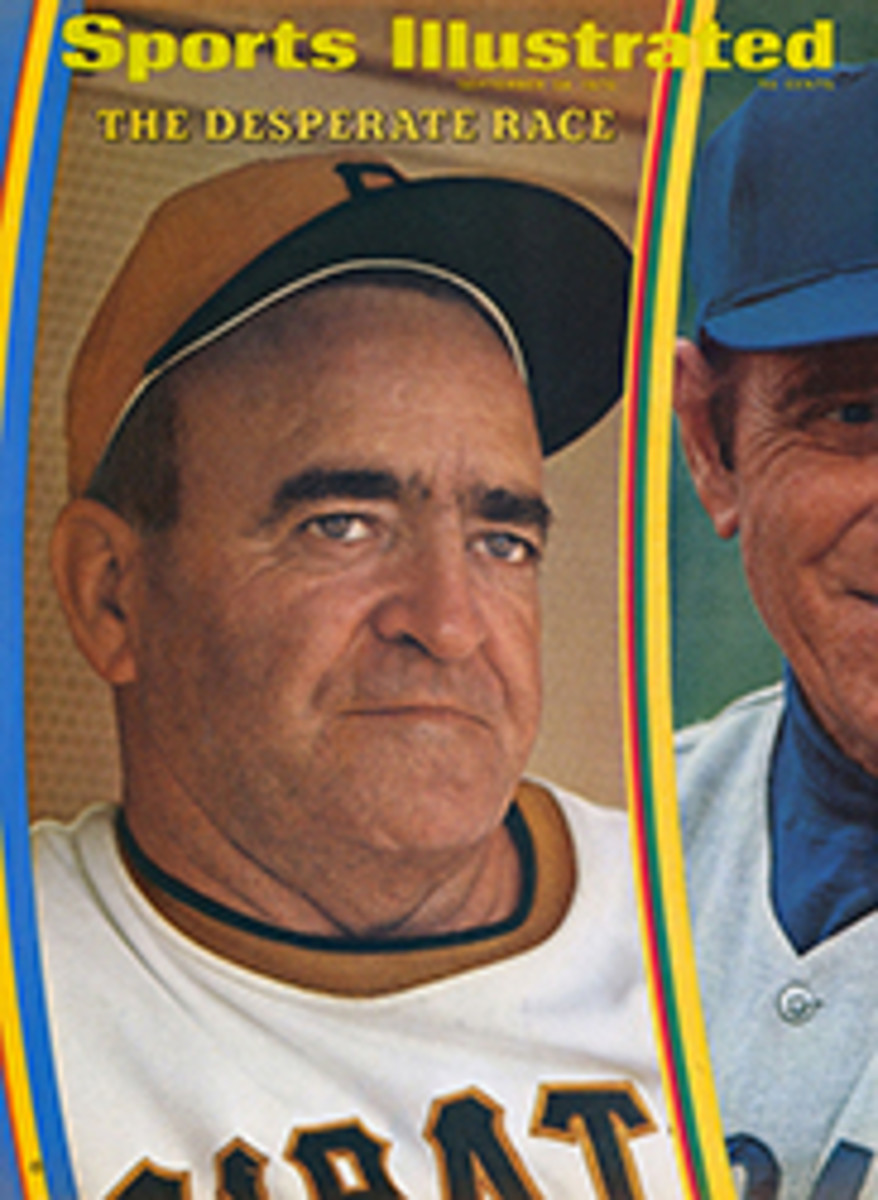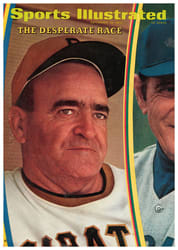
High-ho, high-ho, it's off to lift we go
It might be said that the World Weightlifting Championships, which were held in Columbus, Ohio last week, began on an upbeat. It might also be said that he who is up had better be prepared to be taken down. Which is precisely what happened in Columbus. Before anyone could say Federation Haltersphile Internationale, that body, which governs weight lifting, had disqualified nine of the first 12 medalists for having taken "ups," or amphetamines. It was the first all-out crackdown on drugs in weight lifting, perhaps the most far-reaching ever in any sport, and although the lifters had been warned the FHI would enforce its rule against drugs, no one listened.
The competitors had come from 34 countries, intent upon enjoying themselves, lifting weights and eating. They were taken on a guided tour of a shopping center and sunbathed on the lawn in front of their dormitory—several of them in under shorts. "What else is a man to do if he left his bathing suit in Europe?" said one. And did they eat. Seconds, thirds, fourths...until they were told that their $5-a-day meal ticket entitled them to three meals a day—one at a time.
A minor setback. Vasily Alexeyev, Russia's 6'1", 300-pound superheavyweight, soon provided comic relief. Seems that after one of his workouts he headed for the car he thought was waiting to take him back to the dorm. Seems that the woman in the car was there to pick up her teenage son, and was aghast when Alexeyev flopped into the backseat. "Out," she cried. Poor Vasily, whose command of English is slight, tried to tell her which way to drive him. Pointing toward the dormitory, he said, "Go."
"Out."
"Go."
"Out."
At last help came. Alexeyev got into the right car, but everyone didn't live happily ever after.
Somewhere in Columbus a Dr. Gwendolyn Carson, who was to become more mysterious a figure with each passing day, was making startling findings. Her job was to test urine samples taken from the three top finishers in each of the nine weight classes. Her first tests showed unmistakable evidences of amphetamines, so she phoned Dr. Elmer Diltz, an osteopathic physician and the meet doctor. What they needed was a standard against which the tests could be measured. Dr. Diltz volunteered, took 75 milligrams of amphetamines and had his specimen tested.
These events took place a week ago Sunday. On Monday Dr. Carson made her first report. It indicated that all three flyweight medalists—a Hungarian, a Pole and a Russian—had taken massive doses of stimulants. Clarence Johnson, president of the FHI, convened a meeting of his executive committee the next morning, and it was decided to uphold Article 23, Rule 5(f), which states that any lifter found guilty of taking "dope" may be expelled, and to award the medals to the fourth-, fifth-and sixth-place finishers. By this time the tests of the bantamweights had also been completed, and two of them—a Hungarian and a Pole—were disqualified. Four more lifters were stripped of their medals in the next two days—two Poles, one Japanese and one Hungarian. From then on all tests were negative.
Many competitors, both from Communist bloc nations and elsewhere, complained that it was unjust that specimens from only the first three finishers were examined, since it was a virtual certainty that those who had been moved up also had taken stimulants. The value of taking amphetamines was also debated. Some insisted that it was an advantage. Others, such as former U.S. Olympians Tommy Kono and Isaac Berger and U.S. Coach John Terpak, said that "ups" had merely a psychological effect.
Meanwhile, the Poles, Hungarians and Russians threatened to go home, which, of course, they didn't do, since they knew they still had the three best teams in the meet; indeed, Russia, with 39 points, was the eventual winner, followed by Poland (24) and Hungary (17). Of course, they denied that they had used drugs and claimed that their food must have been doped or that stimulants had been added to the urine samples. Doctors from five countries—the above plus Bulgaria and Spain—criticized the security of the specimens, and a Polish doctor asserted that the specimens were taken in a "paper glass" and that the testing laboratory was "filthy."
These accusations were baseless. The Polish doctor wasn't even on the medical committee, had no firsthand knowledge of the testing procedures and had never seen the lab; the Spanish doctor admitted he had been coerced into signing the complaint, and the Hungarian doctor was caught administering an injection to bantamweight Imre Foldi. At least half a dozen witnesses saw the doctor giving a needle to Foldi backstage during the meet. One was Sergeant Doug Grant of the nearby Worthington police force and head of meet security. Grant and Dr. Diltz later saw the doctor inject Foldi again.
"The doctor said it was calcium for a muscle spasm," Dr. Diltz says. "I went back and 'borrowed' the vial it came from and had it tested. It was a sodium chloride solution, which is used to dilute drugs."
The security was exemplary. Dr. Diltz was the only one who knew Dr. Carson's whereabouts or phone number. There was only one key to the room where specimens were taken, and the safeguarding process was foolproof. One foreign doctor was on duty in that room each night when samples were taken in the presence of Grant and Dr. Diltz. Each sample was poured into four glass vials, the lids of which were immediately taped. The vials were placed in canisters, and a slip of paper bearing the signature of the doctor on duty was taped over the cap. Moreover, during the last few days of the meet, sealing wax was melted over the sides of the canisters and stamped with a one-of-a-kind ivory signet owned by Grant. Two canisters from each contestant's sample were placed in a refrigerator in case there was a request for retesting. The other canisters were locked in Dr. Diltz's attaché case and taken to Dr. Carson's laboratory.
There the samples, which were coded by number rather than being labeled with the weight lifters' names, were tested. As for the lab itself, it is clean and well-secured. And as for those who began to wonder if there really was a Dr. Carson, let it be said that there is, and that she is a highly skilled, almost stately black woman with a Ph.D. who has been. a toxicologist for 25 years and belongs to such august bodies as the International Association of Forensic Toxicologists.
"I tested the specimens myself and had someone else test them to check me," she said last Saturday when she finally agreed to discuss her role. Spread on a table before her were graphs showing the amounts of amphetamines found in the samples. Wavy red lines on the graphs had been drawn after the specimens had been placed in a machine called a Beckman DK-2A ratio recording ultraviolet spectrophotometer. In nine cases the red lines indicated the presence of stimulants. A number of lines went off the tops of the graphs. "One sample had to be diluted 64 times with acid water before we could get it on the chart for a reading," Dr. Carson explained. "Another had to be diluted 32 times."
Dr. Carson scotched the accusation that drugs might have been added to the samples after they had been put into the vials. "Anything added would have deviated from the standard, because it must first be metabolized by the body," she said. Added Dr. Diltz, "At no time has any doctor asked us to retest the samples in the refrigerator. To me, that says a lot."
The fuss and furor unfortunately detracted from the performances by the lifters, who set 18 world records. Two Russians—light heavyweight Gennady Ivanchecnko and middle heavyweight Vasily Kolotov—became the first ever in a world championship to earn four medals in one night, winning the press, snatch, clean-and-jerk and overall. And Alexeyev, none the worse for his misadventure in the automobile, became the first man in history to lift 500 pounds, jerking 501½ en route to amassing a 1,346½ total, which won the superheavyweight division. Serge Reding of Belgium, who barely missed a 505-pound jerk, was second and Kalevi Lahdenranta of Finland came in third. The best performances by Americans were a second for middle heavyweight Phil Grippaldi and a third by heavyweight Bob Bednarski.
Before the championships began, there was a portent that the ceiling might fall in. When the superheavies, who were practicing on the second story of a gym, dropped their 400-pound lifts on the floor, plaster flaked off the ceiling below. All equipment was therefore transferred from the gym to a field house. In all, it took 50 men almost all night to move the 20 tons of weights and gear—and no one popped an "up."
PHOTO
SPECIMENS LOCKED in attaché case, Dr. Diltz is guarded by security man Doug Grant.

